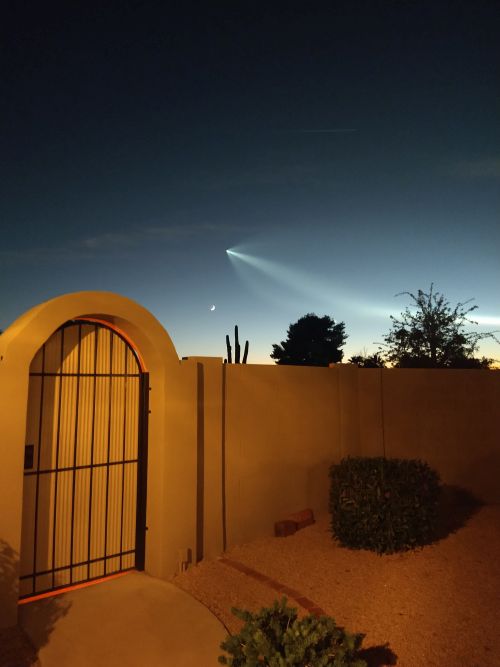
Last night, when I took the dogs out at about 6:20 PM, I looked toward the crescent moon and immediately saw the unmistakable trace of a rocket about to go by above it. Rockets are fast, so rather than run in and try and find my Canon G16 and risk missing it, I pulled out my phone and did my best. It turned out reasonably well, with even a sort of Halloween-y color cast in deep dusk.
It was a SpaceX launch of still more Starlink satellites, from Vandenberg AFB. Before I could get my phone out to take a shot, we saw the first stage drifting down toward a landing on an unmanned landing barge that Elon Musk has whimsically named Of Course I Still Love You.
Although the shot I took wasn’t bad, there is a site detailing the Vandenberg launch schedule, and next time I’m going to be out there with a tripod and my G16.
_…_ _…_
Elon Musk, yeah. He apparently closed the deal to buy Twitter earlier today, and has already fired top management. One of the first corporate directives he’s going to issue is to un-ban all banned users. He’s also going to throttle way back on content moderation, which for Twitter has generally meant censoring anything Twitter’s management doesn’t like.
That may still take some doing. Ironically, if he succeeds in cleaning house along the lines he’s stated, it could mean that several much smaller social networks catering to those who have been banned or censored by Twitter could lose members to a new “big tent” Twitter. We’ll see how that plays out. Musk knows how to get things done, and if anybody can create a social media network that is open to all sides of the political spectrum, it would be him.
_…_ _…_
All this cooks down to some pretty fundamental questions. What are social networks good for? Twitter seems to be a bottomless well of political derangement, which (as you might imagine) I dodge as best I can. I’m active on Twitter because every time I mention my books there, I sell a few. Whatever else I post there are pretty much what I post here now and then as “odd lots,” i.e., links to interesting things, few or none of them having anything to do with politics.
I’ve stated before that Twitter is an “outrage amplifier,” and it’s still true–but then again, any social network can be an outrage amplifier. Twitter seems particularly good at it, which has always puzzled me. Not long back I began to wonder: Is Twitter what it is because so many journalists are on it? Journalism itself (at least outside of vertical market reporting) seems to draw its energy from outrage. If Musk makes the journalist community run screaming from a network it can no longer dominate, what will Twitter become?
Recent news about Meta’s financial crisis suggests that Twitter could in fact become the new Facebook–especially if the old Facebook becomes insolvent. Zuck seems to be pouring all his energy and free cash flow into a virtual world that nobody asked for and nobody wants. Abandoning his Metaverse would be the ultimate humiliation; one has to wonder if he would pull back before the company crashed for lack of cash.
I have an idea that I think I covered here some time back: a social network server into which many independent social networks could connect and trade information according to rules established by each participating network. If people wanted an echo chamber, they could build an echo chamber. If they wanted a wide-open discussion board, they could build that too.
_…_ _…_
I haven’t posted much over the past month because I’ve been beating hard on the 4th edition of my assembly language book. It’s coming out reasonably well, though I really miss the much-maligned Insight debugger, which I featured in the 3rd edition back in 2009. Most Linux debuggers are designed for C and C++ and don’t have an assembly source code view like Insight had. The source for Insight is available online, and if any of you are capable of creating an installable package, I encourage you to do so. I understand that the damned thing is weird internally, containing as it does the whole damned Tcl/Tk interepreter for the sake of its widget set. Or failing that, if anybody can recommend a standalone (i.e., not SASM) Linux debugger with an assembly view, please let me know. I’ve looked at a lot of them, including Nemiver, edb, and DDD without much success. I’ve thought hard about trying to teach my readers command-line gdb, or even gdb TUI, but naked gdb is a quadruple handful. My book is for absolute beginners, and I’ve got page-count constraints that wouldn’t allow me to teach enough of it to be truly useful.
Insight would be my first choice, but I also described Kdbg in the 2009 edition, and although the source is available and I’ve tried to compile it for modern distros like KDE Plasma and Linux Mint Cinnamon, the make failed for reasons that I don’t understand. Nor do I understand why it was pulled from all the Linux repos to begin with. It was robust and relatively easy to use. Could it be built as an appimage? That would be way cool.
Beyond that I’m certainly open to suggestions.










